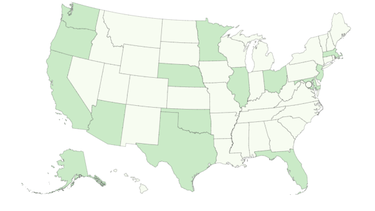Brooklyn resident diagnosed with state’s first case of P.1 variant
— Map from the CDC webpage tracking COVID-19 variants in the United States
The shaded states have reported cases of the P.1 variant of COVID-19. As of Saturday night, the CDC webpage tracking variants in the United States, reported 48 cases of P.1 across 15 jurisdictions. New York confirmed its first case on Saturday; numbers on this webpage are updated on Sunday, Tuesday, and Thursday by 7 p.m.
On Saturday, the first confirmed case of the P.1 variant of COVID-19, commonly referred to as the Brazilian variant, in New York State was announced.
The case was identified by scientists at Mount Sinai hospital in New York City and verified by the Department of Health’s Wadsworth Center Laboratories in Albany, according to a release from the governor’s office.
The patient, in his or her nineties, is a Brooklyn resident with no travel history.
The P.1 variant was first identified in four travelers from Brazil, who were tested during routine screening at Haneda airport outside Tokyo, Japan, according to the Centers for disease control and Prevention. This variant was first detected in the United States at the end of January 2021.
As of Saturday night, the CDC webpage tracking COVID-19 variants in the United States, reported 48 cases of P.1 across 15 jurisdictions.
The CDC also reports that New York State has 136 cases of the highly transmissible B.1.1.7 variant first identified in the United Kingdom; 5,567 cases of the B.1.1.7 variant are reported nationwide — across every state but Oklahoma. Florida has the most cases of B.1.1.7 with 882.
The CDC also reports that New York State has 136 cases of the highly transmissible B.1.1.7 variant first identified in the United Kingdom; 5,567 cases of the B.1.1.7 variant are reported nationwide — across every state but Oklahoma. Florida has the most cases of B.1.1.7 with 882.
The P.1 variant has 17 unique mutations, according to the CDC, including three in the receptor binding domain of the spike protein.
Mutations are changes in the genetic code of a virus that naturally occur over time when an animal or person is infected. Many mutations do not affect the virus’s ability to spread or cause disease because they do not alter the major proteins involved in infection; eventually these are outcompeted by variants with mutations that are more beneficial for the virus.
There is evidence to suggest that some of the mutations in the P.1 variant may affect its transmissibility and antigenic profile, the CDC says, which may affect the ability of antibodies generated through a previous natural infection or through vaccination to recognize and neutralize the virus.
A recent study reported on a cluster of cases in Manaus, the largest city in the Amazon region, in which the P.1 variant was identified in 42 percent of the specimens sequenced from late December. In this region, it is estimated that approximately 75 percent of the population had been infected with COVID-19 as of October 2020. Since mid-December the region has observed a surge in cases. The emergence of this variant raises concerns of a potential increase in transmissibility or propensity for COVID-19 re-infection of individuals.
The P.1 variant has been designated a “variant of concern,” Sunday’s release from the governor’s office said, which means there is evidence of an increase in transmissibility, more severe disease, and the potential for reduced effectiveness of treatments or vaccines. However, while additional research is warranted, researchers at the University of Oxford recently released non-peer reviewed data that indicates the P.1 variant may be less resistant to the current vaccines than originally thought.
The Wadsworth Center is currently sequencing COVID-19 virus specimens at a rate of approximately 90 per day and has sequenced more than 8,200 virus samples statewide, the release said. Most specimens have been selected at random from throughout the state to ensure geographic representation.
Newest numbers
As of Sunday morning, Albany County has had 21,701 confirmed cases of COVD-19, including 71 since Saturday, according to a release from Albany County Executive Daniel McCoy’s office.
Of the new cases, 41 did not have clear sources of infection identified, 24 had close contact with someone infected with the disease, four reported traveling out of state, and two were health-care workers or residents of congregate settings.
“Today marks the fourth day in a row that I have reported a higher number of new positive cases,” said McCoy in the release. “We had 90 on Thursday, 65 on Friday, 64 yesterday and 71 today. We need to stay vigilant.”
The five-day average for new daily positives has increased to 67.6 from 62.4. There are now 508 active cases in the county, up from 483 on Saturday.
The number of Albany County residents under quarantine increased to 1,282 from 1,204. So far, 68,834 residents have completed quarantine. Of those, 21,193 had tested positive and recovered. That is an increase of 42 recoveries since Saturday.
There was one new hospitalization overnight, and there are now 25 county residents hospitalized from the virus, down two from on Saturday. There are still four patients in intensive-care units.
Albany County’s COVID-19 death toll remains at 365.
Statewide, the COVID-19 infection rate, as of Friday as a seven-day rolling average, was 3.3 percent, according to the state’s dashboard.
Albany County, also as of Friday as a seven-day rolling average, had an infection rate of 1.8 percent.



